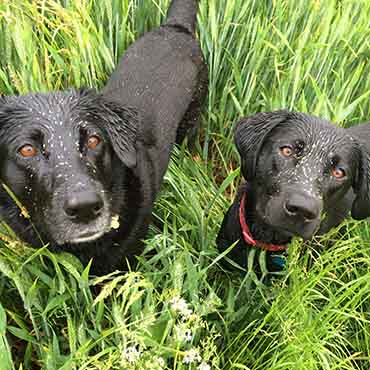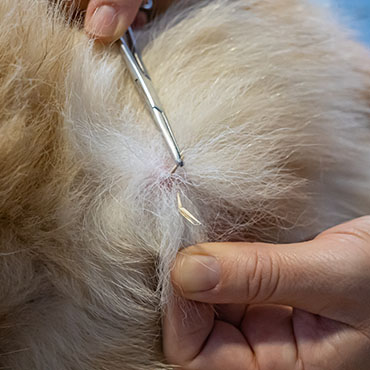Grass seeds in dogs
Overview
- If your dog loves running through long grass, it’s important to check them for grass seeds afterwards.
- Grass seeds might look small and harmless, but in the wrong place, they can cause a great deal of trouble.
- Eyes, ears and toes are common places to find a grass seed, and if they aren’t removed, they often find a way to get under the skin.
- Once a grass seed is under the skin, it’s possible for it to start migrating around the body, at which point they often cause problems and prove difficult to find.
- Contact your vet if you think your dog might have a grass seed stuck somewhere.
General information
Grass seeds might look small and harmless, but in the wrong place, they can cause a great deal of trouble. If your dog has been running in long grass, always check them for grass seeds afterwards, and remove any that you find, especially in between the toes, round their armpits and near their eyes. If you find one stuck, or a wound/swelling that looks like it could contain one, book an appointment with your vet. It’s important to remove grass seeds quickly, because their pointy shape enables them to pierce through skin, enter the body and travel around causing problems such as infections and abscesses.

These two dogs have been in long grass.
Symptoms
Grass seeds often cause problems in the ears, between toes, behind eyelids and sometimes, under the skin and around the body.
- Ears: If your dog has a grass seed in their ear, you may notice them excessively scratching it, or shaking their head.
- Eyes: If your dog has a grass seed stuck behind their eyelid, they are likely to develop a painful, weepy eye.
- Paw: If your dog has a grass seed between their toes, they might excessively lick or nibble their paw, and overtime you might notice saliva staining and a swelling.
- Elsewhere: A grass seed travelling around the body is likely to cause vague symptoms such as a non-healing wound, low energy and an intermittent high temperature.
Treatment
If your dog has a seed stuck in their skin, depending on where it is, it might be possible for your vet to simply pull it out using the right instruments. However, once a grass seed has worked it’s way into the body, they are much harder to find, don’t often show up on x-rays, and can start travelling around causing inflammation, infection and abscesses. Due to the fact they can cause so many problems, even if your vet can’t see or feel a grass seed when they examine your dog, if they suspect one, they might suggest investigating further.
- Eyes: If your dog has a grass seed behind their eyelid, they are likely to need a local anaesthetic or even a sedation or general anaesthetic to have it removed. Your vet will also check the surface of your dog’s eye to make sure the seed hasn’t caused any damage (such as a corneal ulcer).
- Ears: If your dog has a grass seed in their ear, your vet might be able to see and remove it by looking down their ear with a special instrument called a ‘otoscope’. However, if the ear is very painful or the grass seed is deep in the ear your dog may need a sedation for the seed to be removed. If the grass seed has caused an ear infection, your dog will also need treatment for that.
- In-between toes: Finding a grass seed in between toes can be challenging because they often make their way under the skin and cause an interdigital cyst (swelling between the toes). If the grass seed is just beneath the skin, your vet may be able to remove it while your dog is awake, but it’s much more likely that your dog will need an operation to find it.
- Anywhere else: If your vet suspects your dog has a migrating grass seed somewhere in their body, they may recommend sending them to a specialist veterinary centre for a special tests, like a CT scan, and possibly surgery.

Grass seeds may need to be removed by a vet.
Cost
The cost for treating a grass seed problem varies a lot depending on where it’s causing an issue. It’s often relatively inexpensive to treat a grass seed that stuck in the skin, under the eyelid, or in the ear, but costs can quickly mount up if the problem requires a CT scan or surgery. It’s very important to speak openly to your vet about your finances, the cost of treatment, as well as what you think is right for your dog. There may be more than one treatment option, so if one doesn’t work for you and your dog then your vet may be able to offer another.
Consider taking out dog insurance as soon as you bring your dog home, before any signs of illness start. This will give you peace of mind that you have some financial support if they ever become unwell.
Published: July 2020
Did you find this page useful?
Tell us more
Please note, our vets and nurses are unable to respond to questions via this form. If you are concerned about your pet’s health, please contact your vet directly.
Thank you for your feedback
Want to hear more about PDSA and get pet care tips from our vet experts?
Sign up to our e-newsletter
Written by vets and vet nurses. This advice is for UK pets only. Illustrations by Samantha Elmhurst.

